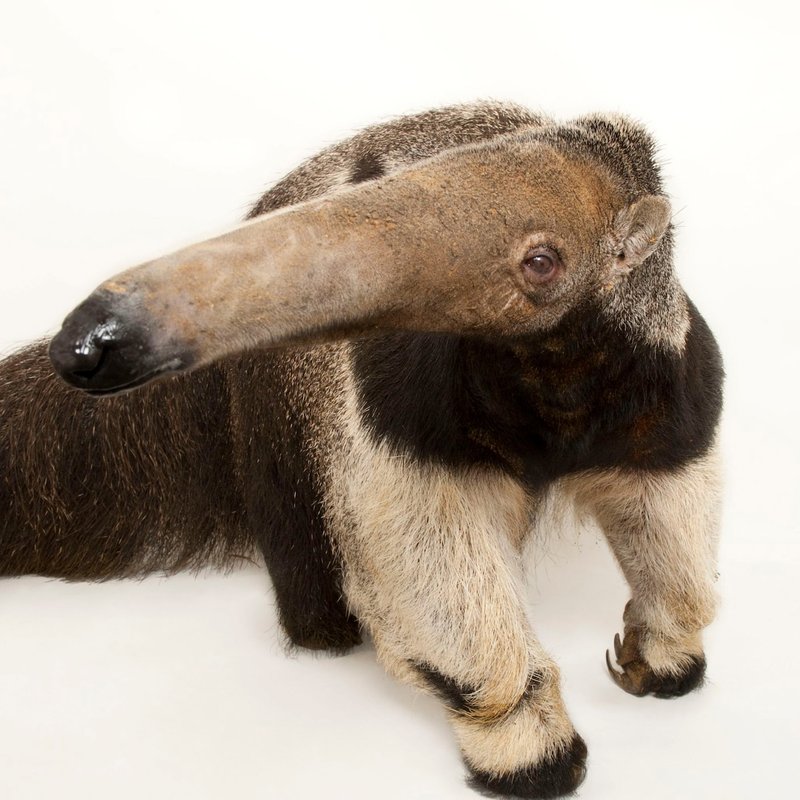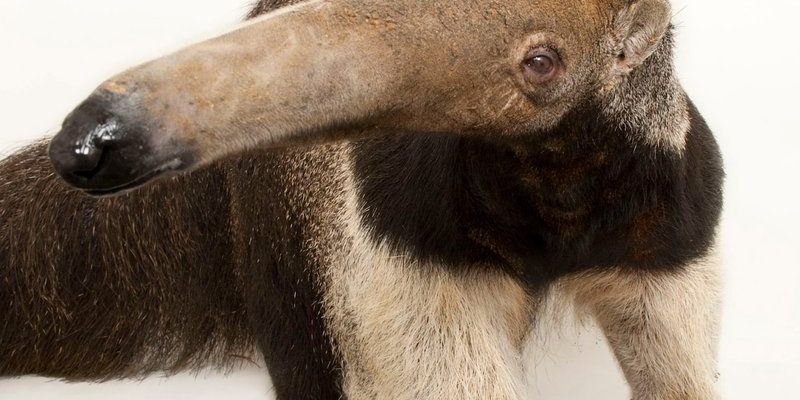
These remarkable creatures can be found in various habitats in Central and South America, from grasslands to rainforests. With their specialized adaptations, giant anteaters have evolved to thrive in environments where few animals can. Let’s explore what makes them so special!
1. Unique Physical Traits
Giant anteaters are hard to miss! They can grow up to 7 feet long, including their tails. That’s like having a miniature couch walking around your backyard! Their most distinctive feature, of course, is their elongated snouts, which can measure up to 12 inches. This long snout is perfect for reaching into ant hills and termite mounds.
Claws are another standout trait. Giant anteaters have powerful claws on their front feet, which they use to dig into ant colonies. These claws can grow up to 4 inches long! But despite this fierce appearance, they are generally gentle giants. Their body is covered in coarse hair, which helps protect them from the bites of the ants they consume.
2. Specialized Diet
You might be wondering what the giant anteater eats. The answer is simple: ants and termites! They have a specialized diet that mostly consists of these little critters, and they can consume over 30,000 insects in a single day. That’s a lot of munching!
Giant anteaters lack teeth, so how do they eat? They use their sticky tongues, which can extend up to 2 feet, to scoop up ants and termites. Think of it like using a long straw to sip up a smoothie. Their tongues are covered in tiny spines called papillae, which help grip the insects as they slurp them up.
3. Digging and Foraging Behavior
Living up to their title, giant anteaters are expert diggers. They can create impressive holes in the ground in search of food. These holes can be quite large, sometimes reaching a foot deep! Their strong claws make quick work of digging, but they also create a mess in their habitats.
When foraging, anteaters rely on their keen sense of smell. They can sniff out ant colonies from quite a distance, allowing them to locate their next meal easily. It’s fascinating how they can differentiate between various scents in their environment. This incredible sense of smell helps them be efficient predators, ensuring they make the most of their feeding time.
4. Solitary Lifestyle
Here’s the thing: giant anteaters are mostly solitary animals. Unlike some species that thrive in groups, you’re unlikely to see them hanging out with friends. They prefer a life of solitude, coming together only to mate. Each anteater has its own territory, which can be quite expansive.
Territories can range from 2 to 10 square miles, depending on the availability of food. They communicate with scent markings to establish their boundaries, making it clear to other anteaters where they can and cannot go. So, if you ever spot one, just know they’re enjoying their alone time!
5. Habitat and Distribution
Giant anteaters are found across a variety of habitats, primarily in Central and South America. They prefer areas with ample food supply, such as grasslands, savannas, and forested regions. Their ability to adapt to different environments is part of what makes them so fascinating.
Despite their adaptability, giant anteaters face threats from habitat loss and hunting. As deforestation continues, their natural environments shrink, forcing them into closer contact with humans. It’s crucial to protect their habitats to ensure their survival in the wild.
6. Remarkable Adaptations
Adaptations are nature’s way of helping animals survive, and giant anteaters are no exception. Their long snouts and tongues have already been mentioned, but their sense of smell is nothing to overlook; it is one of the best in the animal kingdom. This adaptation allows them to find food efficiently.
Another adaptation is their ability to tolerate the formic acid found in ant and termite bites. While many creatures would be affected by these harsh chemicals, giant anteaters have evolved to handle them. It’s like having an immunity to nature’s defense mechanisms!
7. Mating and Offspring
When it comes to mating, giant anteaters don’t have a set breeding season. Instead, they mate year-round, which means there’s always a chance for baby anteaters! After a gestation period of about 190 to 200 days, a single pup is born.
Once born, the pup clings to its mother’s back, riding along as she forages for food. This behavior not only keeps the pup safe but also helps it learn crucial survival skills. You can imagine how cute it must be to see a tiny anteater snuggled on its mother, looking over the world from its perch!
8. Conservation Status
The giant anteater is currently listed as Vulnerable on the IUCN Red List, which means they face some threats in the wild. Habitat loss from agriculture and urban development poses significant challenges. Additionally, they sometimes fall victim to road traffic, which can be deadly.
Conservation efforts are underway to protect their habitats and raise awareness about the importance of these animals. Organizations are working to preserve the ecosystems where giant anteaters thrive while educating local communities about their value.
9. Behavior and Social Structure
You might find it interesting that giant anteaters don’t have a complex social structure. They typically only interact with other anteaters during specific times, such as mating. Outside of that, they keep to themselves and live a peaceful, solitary life.
When faced with threats, giant anteaters will often resort to self-defense. Their size and claws can be intimidating to potential predators. If they feel cornered, they can stand on their hind legs, using their powerful claws and size to ward off attackers. It’s a fascinating mix of grace and power!
10. Cultural Significance
In some cultures, giant anteaters are more than just animals—they hold special significance. They appear in local folklore and are often seen as symbols of strength and resilience. Their unique appearance has even inspired art and stories, showcasing how enchanting these creatures can be.
In addition to cultural tales, scientists study giant anteaters to understand more about ecosystems and environmental health. Their role as insectivores helps maintain balance within their habitats, making them invaluable for agricultural sectors reliant on pest control.
To sum it all up, the giant anteater is not just a quirky-looking animal; it’s a vital part of its ecosystem. With their incredible adaptations, solitary nature, and role in culture, there’s so much more to learn about these fascinating creatures. If you ever get the chance to see one in the wild, consider yourself lucky—that’s a memorable experience!

